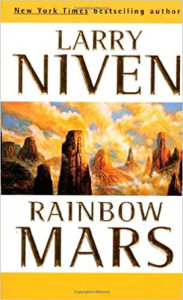 Ah, to visit John Carter and the inhabitants of Barsoom, Edger Rice Burroughs’ richly imagined Mars. The characters in Robert Heinlein’s The Number of The Beast did so, in their travels across the multiverse, and now the protaganist of Rainbow Mars does it. Well, sort of. Maybe. Possibly. Let me explain the confusion that I may have intentionally generated … Larry Niven has stated many times that he firmly believes that time travel is logically impossible — an utter and complete fantasy. So when retrieval specialist Svetz heads back from polluted future Earth in search of extinct animals, he tends to sideslip into fantastic, fictional worlds. And delightfully so in these stories.
Ah, to visit John Carter and the inhabitants of Barsoom, Edger Rice Burroughs’ richly imagined Mars. The characters in Robert Heinlein’s The Number of The Beast did so, in their travels across the multiverse, and now the protaganist of Rainbow Mars does it. Well, sort of. Maybe. Possibly. Let me explain the confusion that I may have intentionally generated … Larry Niven has stated many times that he firmly believes that time travel is logically impossible — an utter and complete fantasy. So when retrieval specialist Svetz heads back from polluted future Earth in search of extinct animals, he tends to sideslip into fantastic, fictional worlds. And delightfully so in these stories.
In short stories collected in The Flight of the Horse (1973), he quests for a Gila monster and gets a fire-breathing dragon, a wolf and retrieves an intelligent werewolf, a horse and finds a unicorn with a very bad temper, and a whale but finds Moby-Dick, complete with the ill-fated Captain Ahab and his harpoon sticking out of the side of the whale. It appears that either Svetz, who hates time travel, or his machine generate a reality straight out of the imagination every time he trips. Ouch. And sometimes quite literally ouch, e.g., when the unicorn tries to impale him. Or the werewolf tries to eat him! Under the command of Secretary-General Waldemar the Tenth, Svetz’s job was “simply” to travel into Earth’s past and retrieve exotic animals. (Far more exotic than he intended!) But Waldemar the Tenth is dead, and Waldemar the Eleventh has another pet project for Svetz to work on: the stars. The new Waldemar is interested in interstellar travel, but that’s pretty well beyond the means of an ecologically devastated 31st-century Earth. But Mars beckons — the intelligent Mars that they read about in the history books that remain from the 20th Century. Errr … historic records if one thinks that Edgar Rice Burroughs and Jules Verne are writers of history!
So Rainbow Mars ups the ante considerably by both space and time travel to explore Mars a.k.a. Barsoom in the deep past, before it was a dead world. As this is Barsoom itself, it’s inhabitated by a menagerie of warring multi-armed sword-wielding Martians from Edgar Rice Burroughs, elements of H.G. Wells’ War of The Worlds (tentacled monsters and heat rays used as death dealing weapons), and lots of less familiar authors’ books. Svetz and his fantasy tripping companions are soon in really big trouble. Other problems that crop up include a gigantic alien tree extending into Mars’s orbit — a living version of the beanstalk elevator in Arthur C. Clarke’s The Fountains of Paradise. Unfortunately, this beanstalk breaks loose and falls to Earth! Now I might argue that such a beanstalk on Earth seems a highly desirable situation, but there are hidden drawbacks, including the aforementioned multi-armed sword-wielding Martians and their long-running war!
The “novel” is not really a novel, as it actually consists of one novella, “Rainbow Mars,” and the short stories that were in The Flight of the Horse. But it’s delicious romp! You know that it’s going to be a great read if you keep in mind that the working title — which was better than the one used — was Svetz and the Beanstalk, and that it was originally going to be written by Larry Niven and Terry Prachett! That didn’t quite work out, but the result’s still quite fine! And did I mention that Svetz discovers what the origin of the Martian canals was?
Though “Rainbow Mars” leads off the book, read the tales from The Flight of the Horse first, as “Rainbow Mars” does build off those tales. Some reviewers have bitterly complained that the novelette is so poorly written that it never should have been published, but that’s just a load of bullocks! “Rainbow Mars” is a superbly written continuation of the earlier tales. This is not to say that Niven can’t write a bad sequel — The Gripping Hand, the sequel to The Mote in God’s Eye (both written with Jerry Pournelle) was a horrid affair. (Shudder!) Rainbow Mars is quite the opposite — a logical extension of the earlier tales set in this multiverse. It’s a fast read, and one that you’ll want to undertake several times. (And a bang on the ear to Tor for re-releasing these long out of print tales! As they did with The Fantasies of Robert A. Heinlein, they’ve allowed readers to own some of the finest fiction one can hope to read!) This book is without doubt Niven’s best release for several years, easily the equal of his Dreampark series with Steven Barnes.
(Tor Books, 1999)
